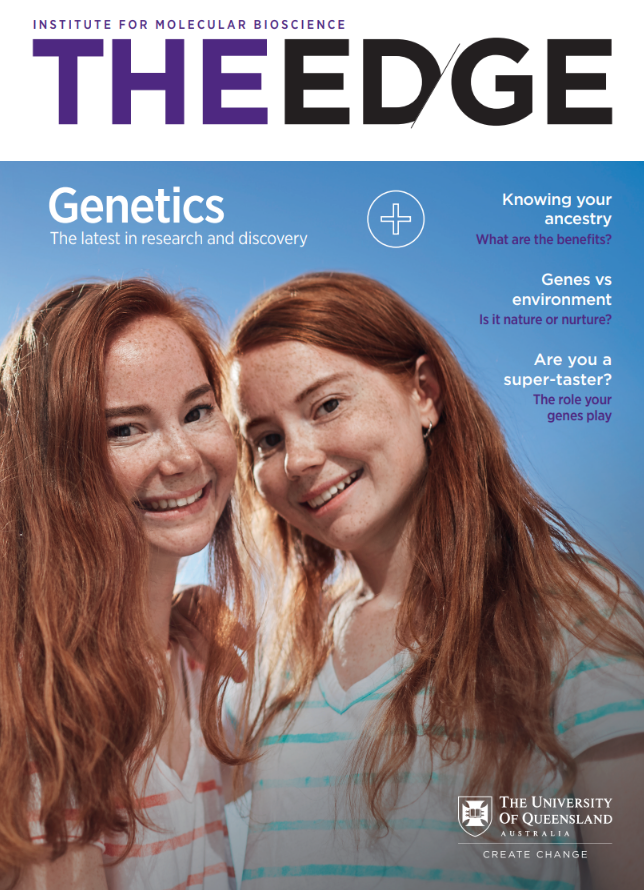Have you ever been tempted to find out your ancestry by doing a DNA test?
Ancestry means different things to different people so we started by asking one of IMB’s geneticists, Associate Professor Loic Yengo, what is ancestry?
“Unfortunately, there is no simple definition upon which all scientists agree,” he says. “When populations are separated (for example, by continents) for many generations, genetic differences between those groups start to emerge. Some of these differences will be encapsulated by the concept of genetic ancestry.”
“Frequencies of DNA variations differ between populations from different parts of the world, and some are explained by how long groups of people have been isolated from others.”
But as populations mix, these genetic differences are reduced.
Blood types are an example of differences between continents – in Australia, 40 per cent of people are O positive, 31 per cent are A positive and only 8 per cent are B positive, whereas in India, the spread is much more even: 28 per cent of people are O positive, 25 per cent are A positive and B positive is the most common with 32 per cent of the population recording this blood type.

More recently, one genetic variant associated with COVID-19 susceptibility was found to be more frequent in people of European ancestry.
For the majority of DNA variants, changes in frequency over generations are purely random, in the same way that certain siblings can be taller than others while having the same parents. However, for a minority of genes, the specific environment (for example, the presence of an endemic parasite) may lead to a change in frequency, which geneticists refer to as “adaptation”.
Sending your DNA to an ancestry company
When you send off your sample to an ancestry company, it is compared to DNA in reference data sets. These contain DNA from people who have good knowledge of their ancestry, for example, they know the birth places of all their four grandparents. If you have combinations of DNA variants that are only found in North Africans or Indians, then you most likely have ancestors from that region. Using these comparisons between your DNA and the reference data sets, you can find out what percentage you are of different ancestries, for example, 60 per cent North African, 10 per cent Finnish.
But as Dr Yengo explains, the reference populations become more informative as more data are added.
“As more people submit their DNA, your inferred ancestry could change slightly to reflect the fact that as more information becomes available, we are identifying more DNA variants overrepresented in single populations.”

Need for more diversity in data
“The caveat is, the more diverse the populations, the more diverse their environments – which creates more unknowns – this is what has pushed researchers to focus on relatively homogenous population groups in the past.”
“A bias towards disease-associated DNA variants identified in people of European ancestry is a known problem in current genetic studies – and indeed this bias also exists in many other areas of medicine.”
“Recognition of this issue is now driving initiatives to collect more diverse genetic data because it is critical to help identify disease-associated genetic variants specific to certain groups.”
“It’s a balancing act for researchers – getting rich data involves large sample sizes with diverse ancestry to help find more disease-associated genes and make the findings more robust, but it also means having to account for the environment and its influences in our calculations,” Dr Yengo said.

Knowing your ancestry could help with personalised medicine
“Different ancestries can have different susceptibilities to disease. So, knowing your ancestry can help assess your risk of disease better, and inform appropriate steps with your lifestyle and have regular health checks.”“Also, as we move towards more personalised treatment, future medicines will be found to be more effective in certain genomes than others – for example, how quickly drugs are metabolised can vary between populations. Knowing your ancestry can help drive decisions by doctors about which medicines to prescribe.”
Disadvantages of testing
Are there any disadvantages to sending off your DNA for analysis? You could find out you are at risk of a certain disease or discover unsuspected relatives. However, most ancestry tests allow you to opt out of receiving information about your disease risk or family members. You can also contact a genetic counsellor if you have concerns about the results of a DNA test.
University research studies are closely regulated by research ethics committees, but the regulation of commercial companies is different, so it is important to read the small print carefully.
So, if you’re on the fence about whether to explore your ancestry, go with a company that allows you to find out only what you want to know – you’ll be learning about yourself while also helping research.
“Using more diverse populations increases our chances of detecting genes that correlate with diseases or traits.” – Associate Professor Loic Yengo


